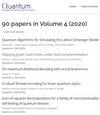On the connection between least squares, regularization, and classical shadows
IF 5.1
2区 物理与天体物理
Q1 PHYSICS, MULTIDISCIPLINARY
引用次数: 0
Abstract
Classical shadows (CS) offer a resource-efficient means to estimate quantum observables, circumventing the need for exhaustive state tomography. Here, we clarify and explore the connection between CS techniques and least squares (LS) and regularized least squares (RLS) methods commonly used in machine learning and data analysis. By formal identification of LS and RLS "shadows" completely analogous to those in CS – namely, point estimators calculated from the empirical frequencies of single measurements – we show that both RLS and CS can be viewed as regularizers for the underdetermined regime, replacing the pseudoinverse with invertible alternatives. Through numerical simulations, we evaluate RLS and CS from three distinct angles: the tradeoff in bias and variance, mismatch between the expected and actual measurement distributions, and the interplay between the number of measurements and number of shots per measurement. Compared to CS, RLS attains lower variance at the expense of bias, is robust to distribution mismatch, and is more sensitive to the number of shots for a fixed number of state copies – differences that can be understood from the distinct approaches taken to regularization. Conceptually, our integration of LS, RLS, and CS under a unifying "shadow" umbrella aids in advancing the overall picture of CS techniques, while practically our results highlight the tradeoffs intrinsic to these measurement approaches, illuminating the circumstances under which either RLS or CS would be preferred, such as unverified randomness for the former or unbiased estimation for the latter.关于最小二乘、正则化和经典阴影之间的联系
经典阴影(Classical shadows,CS)为估算量子观测值提供了一种节省资源的方法,从而避免了穷举状态层析的需要。在这里,我们阐明并探索了 CS 技术与机器学习和数据分析中常用的最小二乘法(LS)和正则化最小二乘法(RLS)之间的联系。通过对 LS 和 RLS "阴影 "的正式识别,我们发现它们与 CS 中的 "阴影 "完全类似--即根据单次测量的经验频率计算出的点估算器--RLS 和 CS 都可以被视为欠定机制的正则化器,用可反转的替代方法取代伪逆。通过数值模拟,我们从三个不同的角度对 RLS 和 CS 进行了评估:偏差和方差的权衡、预期测量分布和实际测量分布之间的不匹配,以及测量次数和每次测量拍摄次数之间的相互作用。与 CS 相比,RLS 以牺牲偏差为代价获得了较低的方差,对分布失配具有鲁棒性,并且对固定数量的状态副本的拍摄次数更为敏感--这些差异可以从正则化的不同方法中得到理解。从概念上讲,我们将 LS、RLS 和 CS 整合在一个统一的 "影子 "伞下,有助于推进 CS 技术的整体发展,而从实践上讲,我们的结果突出了这些测量方法的内在权衡,阐明了在哪些情况下 RLS 或 CS 更受青睐,例如前者的未验证随机性或后者的无偏估计。
本文章由计算机程序翻译,如有差异,请以英文原文为准。
求助全文
约1分钟内获得全文
求助全文
来源期刊

Quantum
Physics and Astronomy-Physics and Astronomy (miscellaneous)
CiteScore
9.20
自引率
10.90%
发文量
241
审稿时长
16 weeks
期刊介绍:
Quantum is an open-access peer-reviewed journal for quantum science and related fields. Quantum is non-profit and community-run: an effort by researchers and for researchers to make science more open and publishing more transparent and efficient.
 求助内容:
求助内容: 应助结果提醒方式:
应助结果提醒方式:


